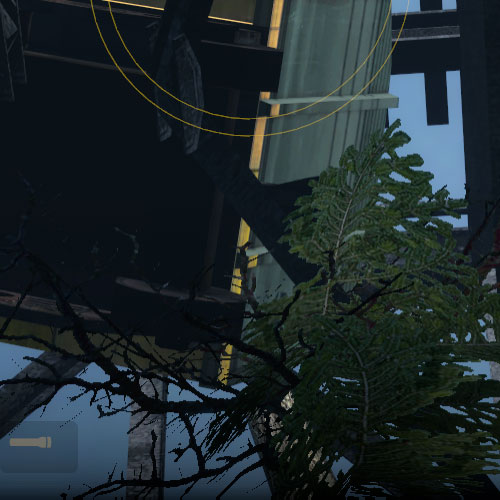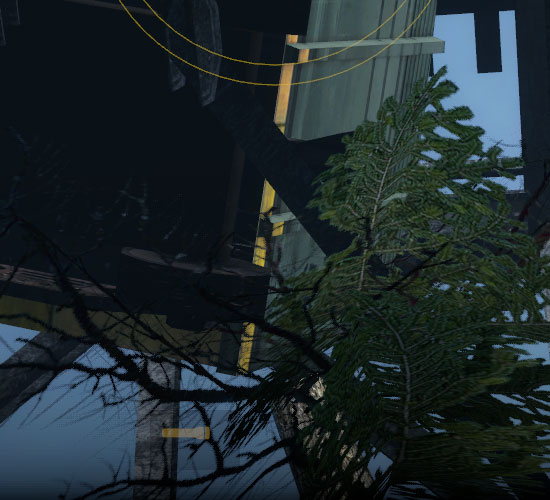AMD's Radeon HD 5870: Bringing About the Next Generation Of GPUs
by Ryan Smith on September 23, 2009 9:00 AM EST- Posted in
- GPUs
The Return of Supersample AA
Over the years, the methods used to implement anti-aliasing on video cards have bounced back and forth. The earliest generation of cards such as the 3Dfx Voodoo 4/5 and ATI and NVIDIA’s DirectX 7 parts implemented supersampling, which involved rendering a scene at a higher resolution and scaling it down for display. Using supersampling did a great job of removing aliasing while also slightly improving the overall quality of the image due to the fact that it was sampled at a higher resolution.
But supersampling was expensive, particularly on those early cards. So the next generation implemented multisampling, which instead of rendering a scene at a higher resolution, rendered it at the desired resolution and then sampled polygon edges to find and remove aliasing. The overall quality wasn’t quite as good as supersampling, but it was much faster, with that gap increasing as MSAA implementations became more refined.
Lately we have seen a slow bounce back to the other direction, as MSAA’s imperfections became more noticeable and in need of correction. Here supersampling saw a limited reintroduction, with AMD and NVIDIA using it on certain parts of a frame as part of their Adaptive Anti-Aliasing(AAA) and Supersample Transparency Anti-Aliasing(SSTr) schemes respectively. Here SSAA would be used to smooth out semi-transparent textures, where the textures themselves were the aliasing artifact and MSAA could not work on them since they were not a polygon. This still didn’t completely resolve MSAA’s shortcomings compared to SSAA, but it solved the transparent texture problem. With these technologies the difference between MSAA and SSAA were reduced to MSAA being unable to anti-alias shader output, and MSAA not having the advantages of sampling textures at a higher resolution.
With the 5800 series, things have finally come full circle for AMD. Based upon their SSAA implementation for Adaptive Anti-Aliasing, they have re-implemented SSAA as a full screen anti-aliasing mode. Now gamers can once again access the higher quality anti-aliasing offered by a pure SSAA mode, instead of being limited to the best of what MSAA + AAA could do.
Ultimately the inclusion of this feature on the 5870 comes down to two matters: the card has lots and lots of processing power to throw around, and shader aliasing was the last obstacle that MSAA + AAA could not solve. With the reintroduction of SSAA, AMD is not dropping or downplaying their existing MSAA modes; rather it’s offered as another option, particularly one geared towards use on older games.
“Older games” is an important keyword here, as there is a catch to AMD’s SSAA implementation: It only works under OpenGL and DirectX9. As we found out in our testing and after much head-scratching, it does not work on DX10 or DX11 games. Attempting to utilize it there will result in the game switching to MSAA.
When we asked AMD about this, they cited the fact that DX10 and later give developers much greater control over anti-aliasing patterns, and that using SSAA with these controls may create incompatibility problems. Furthermore the games that can best run with SSAA enabled from a performance standpoint are older titles, making the use of SSAA a more reasonable choice with older games as opposed to newer games. We’re told that AMD will “continue to investigate” implementing a proper version of SSAA for DX10+, but it’s not something we’re expecting any time soon.
Unfortunately, in our testing of AMD’s SSAA mode, there are clearly a few kinks to work out. Our first AA image quality test was going to be the railroad bridge at the beginning of Half Life 2: Episode 2. That scene is full of aliased metal bars, cars, and trees. However as we’re going to lay out in this screenshot, while AMD’s SSAA mode eliminated the aliasing, it also gave the entire image a smooth makeover – too smooth. SSAA isn’t supposed to blur things, it’s only supposed to make things smoother by removing all aliasing in geometry, shaders, and textures alike.
As it turns out this is a freshly discovered bug in their SSAA implementation that affects newer Source-engine games. Presumably we’d see something similar in the rest of The Orange Box, and possibly other HL2 games. This is an unfortunate engine to have a bug in, since Source-engine games tend to be heavily CPU limited anyhow, making them perfect candidates for SSAA. AMD is hoping to have a fix out for this bug soon.
“But wait!” you say. “Doesn’t NVIDIA have SSAA modes too? How would those do?” And indeed you would be right. While NVIDIA dropped official support for SSAA a number of years ago, it has remained as an unofficial feature that can be enabled in Direct3D games, using tools such as nHancer to set the AA mode.
Unfortunately NVIDIA’s SSAA mode isn’t even in the running here, and we’ll show you why.

5870 SSAA

GTX 280 MSAA

GTX 280 SSAA
At the top we have the view from DX9 FSAA Viewer of ATI’s 4x SSAA mode. Notice that it’s a rotated grid with 4 geometry samples (red) and 4 texture samples. Below that we have NVIDIA’s 4x MSAA mode, a rotated grid with 4 geometry samples and a single texture sample. Finally we have NVIDIA’s 4x SSAA mode, an ordered grid with 4 geometry samples and 4 texture samples. For reasons that we won’t get delve into, rotated grids are a better grid layout from a quality standpoint than ordered grids. This is why early implementations of AA using ordered grids were dropped for rotated grids, and is why no one uses ordered grids these days for MSAA.
Furthermore, when actually using NVIDIA's SSAA mode, we ran into some definite quality issues with HL2: Ep2. We're not sure if these are related to the use of an ordered grid or not, but it's a possibility we can't ignore.
If you compare the two shots, with MSAA 4x the scene is almost perfectly anti-aliased, except for some trouble along the bottom/side edge of the railcar. If we switch to SSAA 4x that aliasing is solved, but we have a new problem: all of a sudden a number of fine tree branches have gone missing. While MSAA properly anti-aliased them, SSAA anti-aliased them right out of existence.
For this reason we will not be taking a look at NVIDIA’s SSAA modes. Besides the fact that they’re unofficial in the first place, the use of a rotated grid and the problems in HL2 cement the fact that they’re not suitable for general use.












327 Comments
View All Comments
Qfromchicago - Friday, November 27, 2009 - link
Windows 7 ProfessionOnkyo 805
Diamond 5870
Still no 3rd option for hd audio.
Has anyone been able to work this thing
charme - Friday, November 27, 2009 - link
same here.no 3rd option for hd audio
otni - Sunday, November 29, 2009 - link
YES, WORKING PERFECT FOR ME...TRY THIS: PLAY THE BLUE-RAY MOVIE THEN GO TO SETTING ON POWERDVD AND CHARGES TO THE 3ER OPTION FOR HD SOUND.IS WORKING FOR ME, THANKS CYBERLINK
FlyTexas - Saturday, November 14, 2009 - link
What good does it do to launch this, if there are still none for sale a month later?Yes, I know there were a few sold up front, but NewEgg has been out for awhile...
RavnosCC - Tuesday, November 17, 2009 - link
The 57xx series are readily available, they also support HD Audio.RavnosCC - Monday, November 23, 2009 - link
"As of today, new PowerDVD 9 Ultra customers will receive build 2320, which includes support for HDMI bitstreaming of undecoded (full quality) audio with ATI Radeon 5000 series graphics cards, and the Auzentech X-Fi Hometheater HD sound card. An update patch for current owners of PowerDVD 9 Ultra is scheduled to be available next Friday (11/27).Tom
Cyberlink"
Qfromchicago - Wednesday, November 25, 2009 - link
Though happy that finally we will get hd audio using powerdvd, but why limit it to new customers only. It seems to me that if you can offer it to new customers, you should be able to offer it to everyone at the same time.Qfromchicago - Sunday, October 18, 2009 - link
I have win 7, a diamond 5870, powerdvd 9 ultra version 2201 and still I don't get he 3rd choice for the HD audio bitstreaming. Has anyone been able to get bitstreaming to work with powerdvd 9. ThanksRavnosCC - Thursday, November 5, 2009 - link
UPDATE: Looks like late November for the mythical patch..."Hi everyone,
Yes... we read these forums regularly. Feedback is forwarded to the appropriate people. These forums aren't the best way for us to provide customer support, so if you have an issue, please open a support ticket through our website.
We can't always comment on new developments... or at least we like to wait until we have a definite answer. I know everyone noticed the reviews for the ATI Radeon 5000 series graphics cards, where certain reviewers were using a pre-release version of PowerDVD 9 to demonstrate HDMI bitstreaming of Blu-ray audio. Support for this feature will be in the next PowerDVD update (patch), which will be available later this month. I don't have a firm date on this, but we're trying to expedite it. Please keep in mind that each of our regular updates includes fixes for new BD titles and new (or forthcoming) hardware / drivers across the PC ecosystem, and so the feature you are anxiously waiting for isn't the only thing that we need to include in the update. Of course, each update has to go through a full quality assurance testing procedure, to make sure that none of the changes introduced any new issues.
So... sorry for going quiet on you... but I and others read every post in this thread and other relevant threads, following up as needed (in some cases, directly through private messages on these forums).
Tom
Cyberlink"
RavnosCC - Wednesday, October 28, 2009 - link
I am in the same boat, with Vista, I have powerdvd 9 ultra fully patched and still no third option for hi-def passthrough... :-/